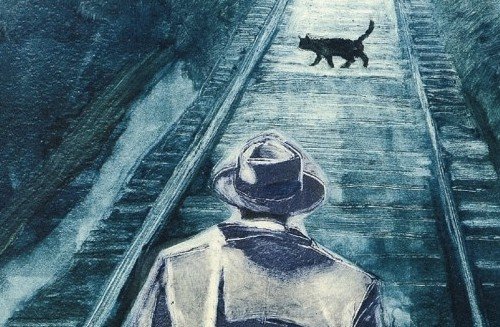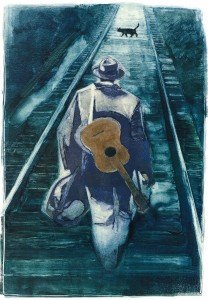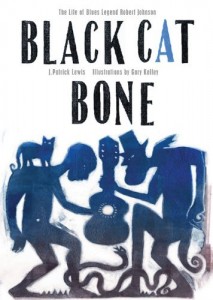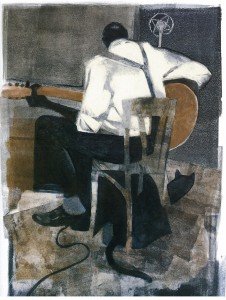“And once it’s written, the history of the blues. They’ll cheer a dead man’s genius. Never ask them whose.”
I know nothing about The Blues. When I was growing up, Dean Martin and the comedy records of Bill Cosby were the only sounds coming from our console stereo. Once I started buying my own music, it was decidedly north of the Mississippi. Way north. While others were discovering the Delta Blues for the first time, I was still dancing to Swedish Pop. I’ve liked what I’ve heard over the years, and I have more than a passing aquaintance with the melancholic state of being that drives the lyrics, but I am a novice when it comes to understanding the music. Black Cat Bone is a window into an unfamiliar world, and appropos to this blog, the road to the blues is paved with illustrative gold.
Recently named Children’s Poet Laureate of the United States, J. Patrick Lewis has done a masterful job of plucking the scant biographical details of Robert Johnson’s life and arranging them into poems that have the rhythm and slide of a blues lyric. Interspersed with actual songs by Robert Johnson, Black Cat Bone reads like a songbook, and by the third page I was ‘singing’ the poems. Luckily, my cat was elsewhere. In an effort to set the mood, I downloaded a few Robert Johnson songs to play as my musical accompaniment while I read the book, but then added The Complete Recordings (1990) to my library, as per Lewis’ suggestion in the end notes at the back of the book. At this early stage of my education, I am happy to take direction.
The first page of Black Cat Bone is a list of notable events of 1911, including the birth of Robert Johnson, the son of a sharecropper in Hazelhurst, Mississippi, ‘a misbegotten dot on a hardscrabble map, halfway between whatnot and nowhere.’ The writing is complex but exquisitely distilled, with the sort of juicy wordplay and colloquialisms that Robert Johnson or his contemporaries might have written. The poems chronicle the short life of the itinerant bluesman, from rural ‘jook’ joints in the deep south to the infamous Crossroads, where Robert Johnson supposedly sold his soul to the devil in exchange for a Luciferian six-string guitar tune-up. In a remarkable display of impatience, the devil took Johnson in 1938 at the age of 27, leaving the world with few recordings, even fewer photographs, but an evergrowing canon of tall tales, legend, truth and conjecture; the seeds, in other words, for the poetry and art of Black Cat Bone.
Gary Kelley’s gorgeous monotypes, mostly in blues and blacks, act as missing pieces in the visual representation of the life of Robert Johnson, but they are also an expression of the time and place inhabited by the early 20th century bluesman.
“I paint with etching inks inks on Plexiglass and then rub off ink and scratch into the ink and paint back into it and roll it and play with it and get all kinds of interesting textures and colors and shapes and then take it in the next room and put it on my little etching press and crank it through the etching press and lift off one image on paper from the painting on the Plexiglass. In Black Cat Bone, I chose to use the monotype medium because of the organic quality of it. It tends to work well with, at least I found, with darker subjects. I love the edges and the textures. It feels like the south in the 1930s and the blues and, you know, the rough edges. It feels like Robert’s music.” *
Indeed. Picture books can be many things, including, as is the case with Black Cat Bone, a diabolically sublime collaboration between poet and artist. A special doff of the hat must go to Creative Editions, the publisher of this book and many other fine art picture book publications. The oversized format and meticulous attention to detail allows for an unfettered expression of creativity, which the music, the art, and the poetry of Black Cat Bone demands.
J. Patrick Lewis was a professor of economics before making the inevitable leap into children’s poetry. The very affable author has written many books for children, and was recently named the Children’s Poet Laureate of the US, and has received the 2011 National Council of Teachers of English Award for Excellence in Poetry for Children.
Gary Kelley received his degree from the University of Northern Iowa and was inducted into the Society of Illustrators Hall of Fame in 2007. The highly prolific artist is responsible for some of the most beautiful picture books ever produced. Gary Kelley resides in Cedar Rapids, Iowa.
Black Cat Bone by J. Patrick Lewis, illustrations by Gary Kelley, published by Creative Editions, 2006
And the Soldier’s Sang by J. Patrick Lewis and Gary Kelley will be published by the Creative Company later in 2011.
In a prior collaboration between J. Patrick Lewis and Gary Kelley, the wonderful Boshblobberbosh (Creative Editions, 1998), the style of the writing and the illustration is completely different but equally brilliant. How is that possible? To strike gold, two, three, four times? I dunno…it’s like some deal was struck, or something.
The Legend of Sleepy Hollow by Washington Irving with illustrations by Gary Kelley was previously reviewed in the blog.
~Thanks to the University of Alberta Bookstore, and especially their savvy book buyer for adding this book and others like it to their inventory
*Iowa Public Television






Maybe that wasn’t a coincidence that your cat had left the room 🙂